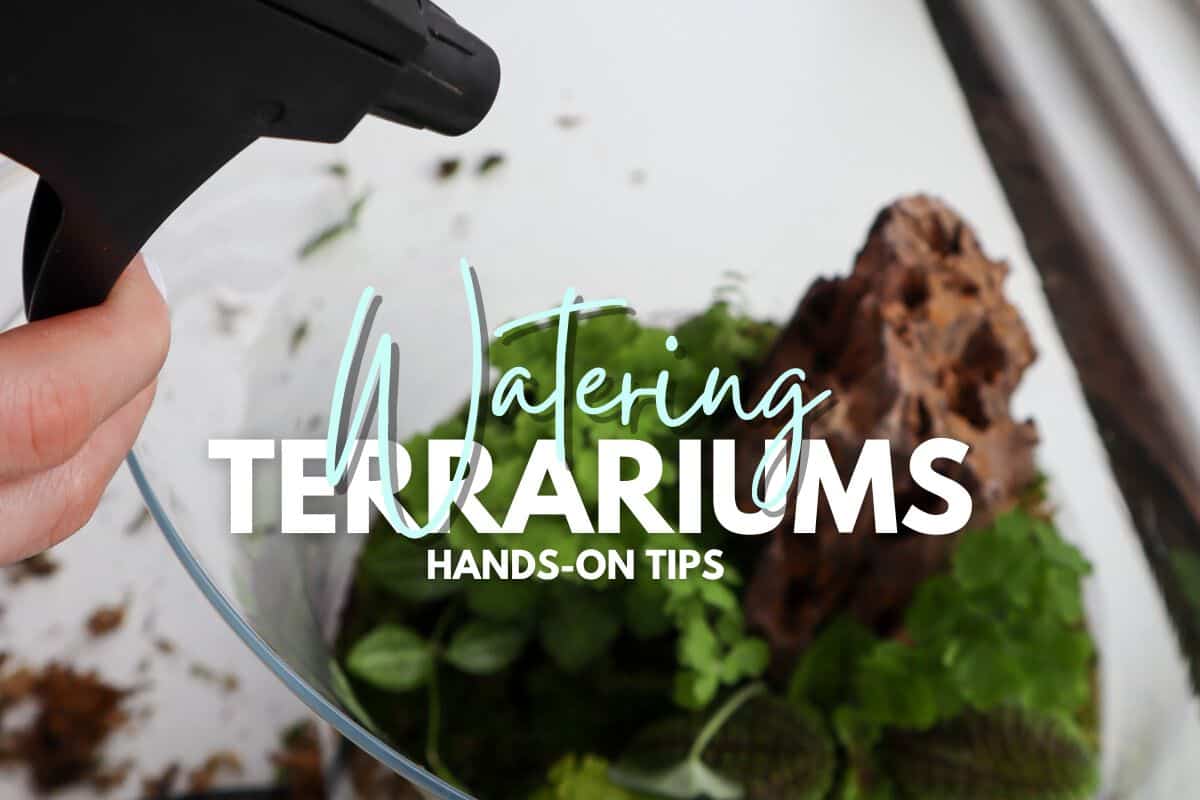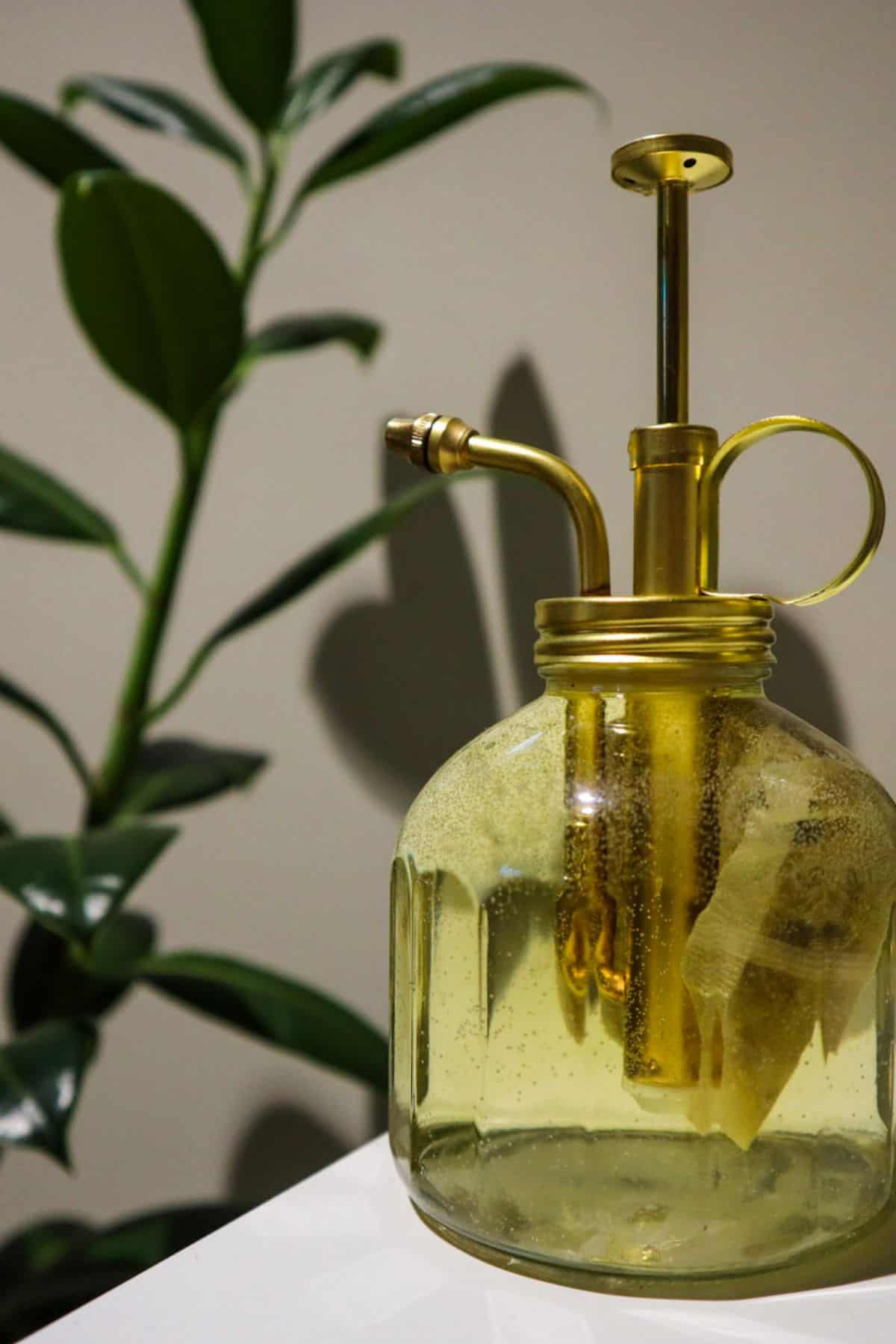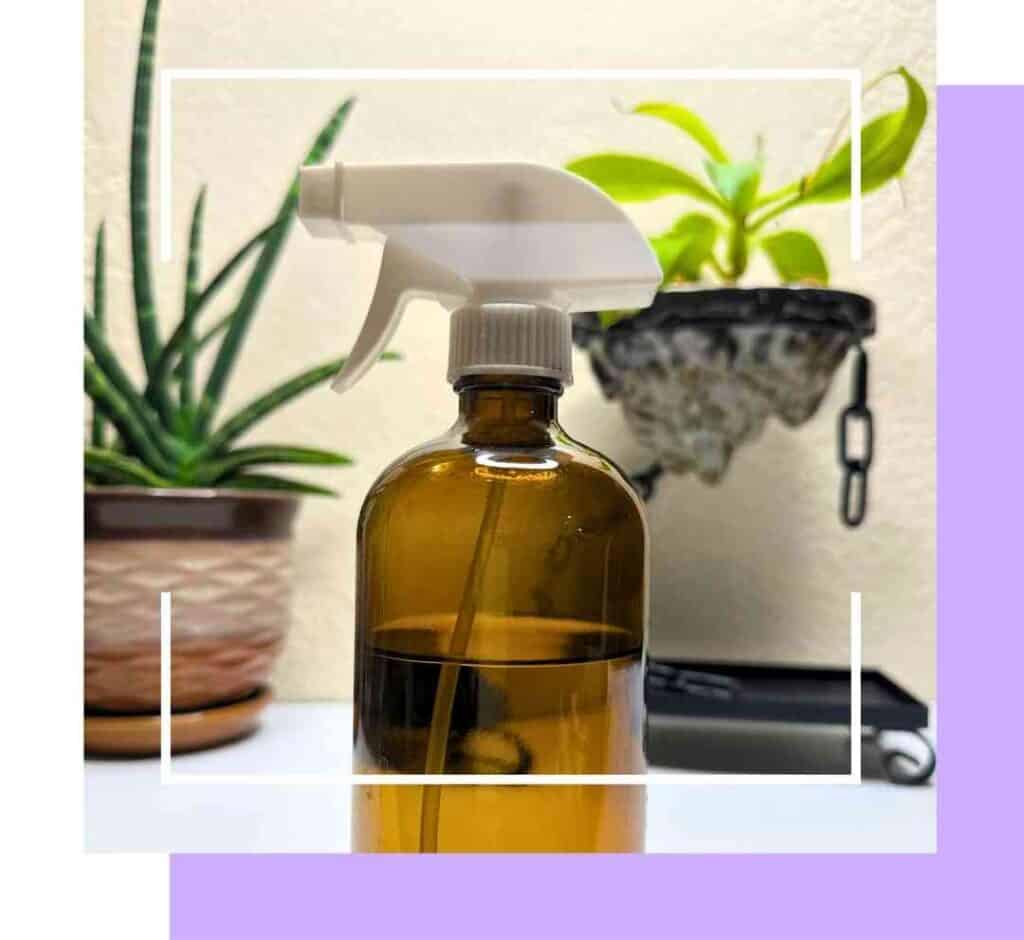The practice of watering a terrarium seems like a simple one.
Water + Terrarium = Win?
But honestly, it’s one of the most common questions people have about caring for terrariums, and it’s something plenty of people seem to get wrong.
After all, terrarium ecosystems operate on a fine balance. Too much or too little water can both have dire negative impacts.
Too much, and you’re risking rot and mold. Too little and well… things go south in a different way.
Every terrarium is going to have different watering needs, but there are some common practices to follow to have the best chance of getting it just right.
So, put down the hosepipe and take a look at the right way to water a terrarium.

Terrarium Tribe is reader-supported. When you purchase through links on our site, we may earn an affiliate commission (at no further cost to you). 💜
When to Water a Terrarium
Knowing precisely when to water a terrarium is half the battle.
We often hear of people’s terrariums going months without a top up, whereas I find it hard to leave them alone that long. Just a little more water won’t hurt, right?
We’ll add “just a little more” again and again till it becomes a holiday home for Shrek.

Thankfully, there are plenty of indicators to look out for, and you shouldn’t be adding more water to your terrarium unless at least one of these is present.
Dry Substrate
Most terrariums are going to be housing tropical plants that require lots of moisture to thrive. For this, a substrate with high water retention but good drainage is critical.
So, generally speaking, the substrate should never be dry.
The first and most obvious way of testing is to just get your hands dirty and feel it!

Or, (if you don’t want to get your hands dirty), you can check the condensation levels against the glass through the substrate level. An evenly moist substrate will show beads of condensation throughout the whole layer.
No Visible Condensation
It’s not just the substrate level that should show condensation. A closed terrarium ecosystem with an effective water cycle should display some condensation throughout the container at certain points throughout the day.
Generally during the morning and midday sun, when temperatures are at their highest.
Here, you’ll see some misting up of the glass.

As noted earlier, if you can see condensation through the substrate layer, then there’s some moisture there.
However, if there’s no condensation throughout the top of the terrarium, that’s a strong sign that there’s little to no humidity and likely insufficient water in the system as a whole.
Crispy, Yellowing, or Wilting Leaves
Finally, just check your plants.
Hopefully, you’ll be able to fix any dryness issues before your plants start to suffer, but if you spot any of these, then there’s a good chance you need to add more water immediately.
Most plants are going to indicate if they’re struggling with a lack of water. The most common negative indicators to look out for are to be found in the leaves.
- Dryness/crispiness.
- Fading/discoloration.
- Wilting/drooping.

Of course, every plant is different, but these are pretty universal.
Some plants are far more sensitive than others to watering. For example, Fittonia plants are the damsels of the plant world and are prone to fainting at the first sign of dryness.
So take care that you don’t overwater your whole terrarium whilst trying to keep one particular plant happy. It’s important to understand the needs of individual plants to get your watering system perfected.
How Often to Water a Terrarium
There is no single-fit watering schedule for terrariums.
There’s a balance to be struck between little and often and few and far between.
On one hand, adding just a little at a time will make sure you’re not overwatering the plants or grossly oversaturating the substrate. But by constantly opening up a closed terrarium to add water, you’re never letting it settle into a healthy terrarium water cycle.

How often to water your terrarium depends on your terrarium size, materials, plants, and environmental conditions.
As a rough guide, a typical closed terrarium will need to be topped up with water every couple of months. More so if you regularly ventilate your terrarium.
How to Water a Terrarium
Watering a terrarium is a lot like playing Rock, Paper, Scissors.
It’s deceptively simple to play, involves a large degree of guesswork, and it’s very easy to get wrong.
Which is why we take a considered approach to watering.
Misting is Best
Using a simple water bottle with a spray function is always recommended (or a mister/atomizer if you prefer).
If you glug water out of a bottle or a tap directly, you’re likely to flood some areas of your terrarium and neglect others.
For the most part, you want an even distribution of water. If some local areas have more water-demanding plants, then you can directly add more water by spraying that area directly or pipetting some water directly on top of them.
I also like to spray the insides of the container a little to clean off any dirt that’s picked up the sides.
At first, I started using a fancy little mister but found it sprayed deceptively little water.

These days, I just recommend a high-quality spray bottle with an adjustable nozzle.

Terrarium Spray Bottle (16oz) | Amber Glass
Compact, versatile (and very pretty) terrarium mister.
Available on the Terrarium Tribe Store.
Adding the Right Amount of Water
Knowing when to stop adding water is what I find the most difficult.
Watering my plants feels like I’m showing them love, and I have a lot of love to give…
Generally, the idea is to evenly saturate the substrate with water but leave no area sodden and no standing water on top, or below the substrate layer.
If you have a false bottom layer, it’s usually fine if there’s a small amount of water that seeps through to the pebble (or, preferably LECA) base. It helps to maintain the humidity, and as long as the water doesn’t reach the substrate, it won’t wick up and risk rotting the roots.

To achieve the best saturation level, it’s best to add a moderate amount of water at a time and then leave the moisture to permeate. If you try to go from dry to perfectly saturated in one go, it’s easy to overdo it (and much harder to correct).
What is the Best Water for a Terrarium?
Water straight from the tap isn’t ideal for terrariums.
Chlorine isn’t great for plants, but at the levels present in tap water, it’s unlikely to do much damage. You can always let tap water sit for 24 hours to let the chlorine evaporate off.
The real issue is the salts found in tap water. Again, they’re unlikely to harm your plants, but they can leave white streaks on your container over time. Not harmful, but not ideal.
Thankfully, there are a few types of suitable water that we can buy.
- Reverse osmosis water – ultra-pure, but ultra-expensive.
- Distilled water – next level down, very pure but still fairly pricey.
- Deionized water – water with the salts removed. Tends to be sold for use in car batteries and is much cheaper. I buy this in bulk.

Over to You
How do you water your plants?
Honestly, getting terrariums perfectly balanced can be fairly challenging. Check out our terrarium care guide for more help.

This was extremely helpful since I am just starting to put together my terrarium with some succulents. Thank you.
Succulents will die in a closed terrarium. They are desert plants that do not like humidity.
Yes, thanks very much indeed for the info on watering. I’m new to this and would have had a clue. Didn’t realise is was such a precision game. Thankyou again. Joe
Hi lightly mist every morning. To mimic morning dew. Also I use a good quality thermometer/hydrometer to let me know humidity level in the vivarium. Your eyes and hands are a great tool mentioned in the article as well.
I am new to this and have an open terrarium.Is this advice applicable to open terrarium?
Some of it is. Though, open terrariums generally won’t generate humidity or condensation (so you’ll have to figure out when they need watering the old fashioned way) and they’ll require watering much more regularly as they don’t trap moisture.
I received an open terrarium as a gift. I think the plants are air plants. The base is filled with pebbles. I am not sure how to care for it. I have it on the counter away from direct light and I have not watered it yet. Suggests?
Ps. – I signed up for you news letter and hope you can help me with my questions.
Thank you.
Hi Katherine, air plants actually have pretty unique care requirements. They’ll likely need regular misting or you can look up how to dunk/soak them.
Hi Katherine,
I have air plants growing in a seashell. I spray them with distilled water about once a week. Always spray from each side, never from the top. Since they shouldn’t be rooted, you can take them out to spray them and just pop them back in after. I hope this helps!
Hello all, just yesterday I restarted two new terrariums : one open and one closed. The closed one is in the critical phase because I need to determine the proper watering phase from the start. Your article is very informative.
Thanks Sal, glad to help!
I use a mister and spray it down 2 times a week, I stick my finger and if the dirt sticks that indicates to me that it is good, my terrarium has been thriving and doing well with how I do it like that.
I have open terrarium for sale in my local coffee shop. I’m really bummed because I have been misting and also spraying sides to let water wet sides. I just realized I’ve been staining the interior of the glass! Of course after reading your advice I will fill all bottles with distilled only. Can you suggest how to clean interior glass safely? I’m so passed I didn’t anticipate this. Thanks so much for your advice.
Sincerely,
Roselle
Honestly, I think it’s a tough one to do safely with plants inside. Vinegar and lemon water are both recommended for cleaning glass, but they also function as weed killers…
Thanks Dan, this was super helpful. I recently purchased Sarracenia plants, which require RO water. So I did wonder if I can use this for my closed terrarium. Thanks for confirming
Hi Dan, awesome website and just getting started with my first terrarium. I notice you don’t mention rainwater as an option. Good or bad idea?
Thanks Ray, that’s a great point! I’ve never been in a good position to collect it myself but rainwater seems like a solid choice for terrariums.
Cool thanks. I have plenty so will give it a try and let you know how it goes!
Hi
In the summer I am collecting air conditioner drain water and in the winter I am collecting rain water, I guess that’s the best?
No idea on the air conditioner water, but rain water is great. 👍
I’ve been growing succulents and got myself a couple of air plants a while back. I had the idea to sit a cactus, in its pot, on top of a blue glass pitcher whose handle is threatening to break.
It is behaving like a closed terrarium with a little ventilation from the pitcher’s spout and so far, (it’s been a week) the air plants seem to love it.
I will let you know if the love affair continues.
Thanks for the great advice on closed terrariums.
That’s so creative Tina!
Just starting a closed terrarium. Can I use rain water? I feed all my air plants, house plants with it at the moment. Thank you.
Yeah, absolutely 🙂
I just put together a 55 gal tropical terrarium from an old aquarium using existing glass top panels (slight gaps) and aquarium light w timer. Also used the false bottom plus layers as suggested. This is at my work in an indoor hallway so no natural light. It’s been about a week and I’ve misted once but feel it may be too dry. The polka dot plant and syngonium both had dry leaves today. Is it ok to mist the substrate directly? And is the aquarium lighting ok for the long haul? Thanks so much I’m learning a lot from you!
Hi Lauri, misting the substrate directly is absolutely fine (in fact some plants don’t like wet leaves so it can be a good thing), and aquarium lighting should be a-okay.